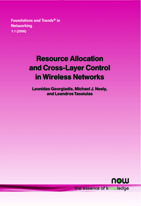Resource Allocation and Cross-Layer Control in Wireless Networks
By Leonidas Georgiadis, Aristotle University of Thessaloniki, Greece, leonid@auth.gr | Michael J. Neely, University of Southern California, USA, mjneely@usc.edu | Leandros Tassiulas, University of Thessaly, Greece, leandros@uth.gr
Abstract
Information flow in a telecommunication network is accomplished through the interaction of mechanisms at various design layers with the end goal of supporting the information exchange needs of the applications. In wireless networks in particular, the different layers interact in a nontrivial manner in order to support information transfer. In this text we will present abstract models that capture the cross-layer interaction from the physical to transport layer in wireless network architectures including cellular, ad-hoc and sensor networks as well as hybrid wireless-wireline. The model allows for arbitrary network topologies as well as traffic forwarding modes, including datagrams and virtual circuits. Furthermore the time varying nature of a wireless network, due either to fading channels or to changing connectivity due to mobility, is adequately captured in our model to allow for state dependent network control policies. Quantitative performance measures that capture the quality of service requirements in these systems depending on the supported applications are discussed, including throughput maximization, energy consumption minimization, rate utility function maximization as well as general performance functionals. Cross-layer control algorithms with optimal or suboptimal performance with respect to the above measures are presented and analyzed. A detailed exposition of the related analysis and design techniques is provided.
Resource Allocation and Cross Layer Control in Wireless Networks
Information flow in a telecommunication network is accomplished through the interaction of mechanisms at various design layers with the end goal of supporting the information exchange needs of the applications. In wireless networks in particular, the different layers interact in a nontrivial manner in order to support information transfer. Resource Allocation and Cross Layer Control in Wireless Networks presents abstract models that capture the cross layer interaction from the physical to transport layer in wireless network architectures including cellular, ad-hoc and sensor networks as well as hybrid wireless-wireline. The model allows for arbitrary network topologies as well as traffic forwarding modes, including datagrams and virtual circuits. Furthermore the time varying nature of a wireless network, due either to fading channels or to changing connectivity due to mobility, is adequately captured in this model to allow for state dependent network control policies. Quantitative performance measures that capture the quality of service requirements in these systems depending on the supported applications are discussed, including throughput maximization, energy consumption minimization, rate utility function maximization as well as general performance functionals. Cross-layer control algorithms with optimal or suboptimal performance with respect to the above measures are presented and analyzed. A detailed exposition of the related analysis and design techniques is provided. The emphasis in the presentation is on describing the models and the algorithms with application examples that illustrate the range of possible applications. Representative cases are analyzed in full detail to illustrate the applicability of the analysis techniques, while in other cases the results are described without proofs and references to the literature are provided.
